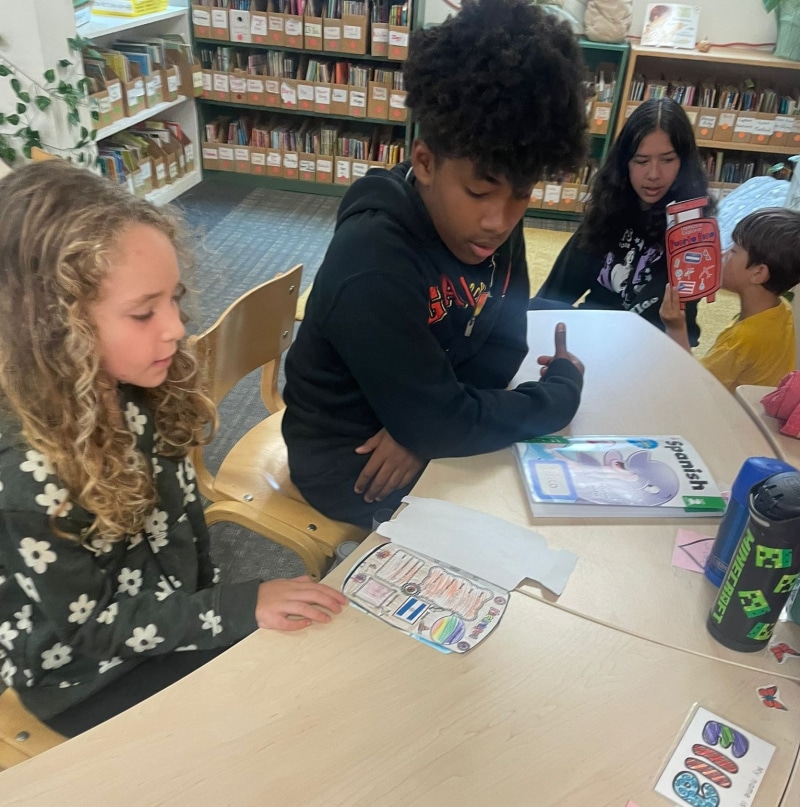Spanish
Aligned with ACTFL standards, the curriculum is designed as a spiral, with recurring themes and vocabulary that deepen in complexity. Through engaging activities, storytelling, songs, and cultural exploration, students build communication skills in meaningful ways, emphasizing listening, speaking, reading, and writing, while promoting global awareness and empathy. Cross-disciplinary projects connect language learning to real-world contexts, allowing students to experience Spanish as a living language in their everyday lives.
Middle school classes are differentiated to meet proficiency needs. In 6th grade, Foundations is offered for students without prior experience in Spanish. In all grades (6th-8th), Pathways and Immersion levels are offered.
Preschool
Children experience the joy of learning a language through songs, games, and hands-on activities. Basic vocabulary (greetings, colors, shapes, numbers 1–10, and animals) become familiar through repetition and auditory practice. Cultural awareness is introduced through age-appropriate celebrations and songs. The focus is on engaging, movement-based learning that builds curiosity and lays the foundation for more structured instruction.

Kindergarten
Foundational skills are built through engaging annual units such as Latin & Hispanic Heritage Month, Día de los Muertos, and daily routines. Students expand their vocabulary related to animals, numbers, colors, emotions, and cultural celebrations. Cross-curricular units connect with classroom themes, supporting language development through real-world context. Hands-on projects, like exploring emotions, fruits and vegetables, body parts, the chicken lifecycle, and farm animals, make learning meaningful and fun. The focus remains on oral communication and cultural awareness, setting a strong foundation for continued Spanish learning.

1st Grade
Building on foundations with themes like “All About Me” and family, students continue to learn annual units such as Latin & Hispanic Heritage Month and Día de los Muertos. Students expand vocabulary related to seasons, weather, clothing, and pets. Special projects, like studying Frida Kahlo, exploring food, and learning about dinosaurs, spark creativity and connect with classroom learning. Oral communication and cultural appreciation are reinforced through engaging, interactive activities.

2nd Grade
Spanish expands to community and global themes, with units on Latin American countries, Día de los Muertos, and the Aztec god Huitzilopochtli (El Colibrí). During their Ornithology Project, students explore Latin American birds. Special lessons on weather, clothing, and seasons deepen vocabulary and cultural understanding. Cross-curricular activities enrich learning, helping students view the world through a Spanish-speaking lens.

3rd Grade
Foundational language skills are strengthened through units on family and parts of the house. Students explore Mexican culture in a cross-curricular social studies unit that includes ancient civilizations like the Maya, the game Pok-Ta-Pok, and landmarks like Chichén Itzá. Projects such as building ofrendas for Día de los Muertos and celebrating fall and winter holidays connect language with meaningful cultural experiences. Latin & Hispanic Heritage Month and calendar/weather units further expand vocabulary in real-world contexts, making Spanish engaging and relevant.

4th Grade
Cultural learning deepens through the study of Hispanic countries such as Bolivia, Argentina, and Costa Rica. Students engage in native speaker interviews, explore poetry and fables, and participate in cross-curricular projects tied to Women’s History Month. These activities build vocabulary and cultural awareness while reinforcing traditional units like Latin & Hispanic Heritage Month and Día de los Muertos.

5th Grade
Afro-cuban music and pre-Hispanic culture are integrated into the curriculum as students study the natives of Mesoamerica and collaborate with music, visual art, and humanities units. Special projects include creating pre-hispanic altars and composing market songs. The Sensemayá video project and refugee map labels add depth and practical application. Cross-curricular work is vital in this grade, blending historical, cultural, and artistic dimensions. Students develop a richer understanding of diverse Spanish-speaking cultures through a variety of media.

6th Grade
Students explore vocabulary and structures related to daily life, school, home, and community. They participate in cross-curricular projects such as designing virtual homes using Tinkercad software and presenting them in Spanish; building mini altars for Día de los Muertos; musical performances in Spanish for school events; and Design Your Own Country in humanities, using Spanish to describe geography and culture of their imagined nations.
Students take field trips into the Spanish-speaking world -- virtually, to La Fundación Mona, a primate rescue center in Spain, where they learn about conservation and animal welfare, and locally, on trips to the Mission District.

7th Grade
Students engage in rich thematic units such as Argentina Wonders, Poetry Month, Inventions, Mi Agencia de Viajes, and the Seven Wonders of the World. Cross-curricular projects include Black History Month with the science department, alebrijes for Día de los Muertos with the art department, and song interpretation and performance with the music department. Students create comic books, explore Hispanic legends, and study famous landmarks through geography. Celebrations like festividades de invierno and Latin & Hispanic Heritage Month deepen cultural appreciation. Grammar and literature are thoughtfully integrated, enriching communication skills and cultural understanding through meaningful, creative learning.

8th Grade
Students explore themes such as daily routines, nature and the environment, pre-Hispanic drinks, and Latin American cuisine. Projects include Mi Diario de Deseos y Sueños, travel itineraries, and mini altars for Día de los Muertos. A cultural exchange between Chile and Japan fosters global connections. Students study Hispanic countries and read literature tied to each unit to deepen comprehension and cultural insight. Publication of the monthly newspaper El Oso empowers students to write and publish in Spanish. These creative and meaningful experiences strengthen language skills while connecting students to real-world issues and diverse traditions.

Preschool
Children experience the joy of learning a language through songs, games, and hands-on activities. Basic vocabulary (greetings, colors, shapes, numbers 1–10, and animals) become familiar through repetition and auditory practice. Cultural awareness is introduced through age-appropriate celebrations and songs. The focus is on engaging, movement-based learning that builds curiosity and lays the foundation for more structured instruction.

Kindergarten
Foundational skills are built through engaging annual units such as Latin & Hispanic Heritage Month, Día de los Muertos, and daily routines. Students expand their vocabulary related to animals, numbers, colors, emotions, and cultural celebrations. Cross-curricular units connect with classroom themes, supporting language development through real-world context. Hands-on projects, like exploring emotions, fruits and vegetables, body parts, the chicken lifecycle, and farm animals, make learning meaningful and fun. The focus remains on oral communication and cultural awareness, setting a strong foundation for continued Spanish learning.

1st Grade
Building on foundations with themes like “All About Me” and family, students continue to learn annual units such as Latin & Hispanic Heritage Month and Día de los Muertos. Students expand vocabulary related to seasons, weather, clothing, and pets. Special projects, like studying Frida Kahlo, exploring food, and learning about dinosaurs, spark creativity and connect with classroom learning. Oral communication and cultural appreciation are reinforced through engaging, interactive activities.

2nd Grade
Spanish expands to community and global themes, with units on Latin American countries, Día de los Muertos, and the Aztec god Huitzilopochtli (El Colibrí). During their Ornithology Project, students explore Latin American birds. Special lessons on weather, clothing, and seasons deepen vocabulary and cultural understanding. Cross-curricular activities enrich learning, helping students view the world through a Spanish-speaking lens.

3rd Grade
Foundational language skills are strengthened through units on family and parts of the house. Students explore Mexican culture in a cross-curricular social studies unit that includes ancient civilizations like the Maya, the game Pok-Ta-Pok, and landmarks like Chichén Itzá. Projects such as building ofrendas for Día de los Muertos and celebrating fall and winter holidays connect language with meaningful cultural experiences. Latin & Hispanic Heritage Month and calendar/weather units further expand vocabulary in real-world contexts, making Spanish engaging and relevant.

4th Grade
Cultural learning deepens through the study of Hispanic countries such as Bolivia, Argentina, and Costa Rica. Students engage in native speaker interviews, explore poetry and fables, and participate in cross-curricular projects tied to Women’s History Month. These activities build vocabulary and cultural awareness while reinforcing traditional units like Latin & Hispanic Heritage Month and Día de los Muertos.

5th Grade
Afro-cuban music and pre-Hispanic culture are integrated into the curriculum as students study the natives of Mesoamerica and collaborate with music, visual art, and humanities units. Special projects include creating pre-hispanic altars and composing market songs. The Sensemayá video project and refugee map labels add depth and practical application. Cross-curricular work is vital in this grade, blending historical, cultural, and artistic dimensions. Students develop a richer understanding of diverse Spanish-speaking cultures through a variety of media.

6th Grade
Students explore vocabulary and structures related to daily life, school, home, and community. They participate in cross-curricular projects such as designing virtual homes using Tinkercad software and presenting them in Spanish; building mini altars for Día de los Muertos; musical performances in Spanish for school events; and Design Your Own Country in humanities, using Spanish to describe geography and culture of their imagined nations.
Students take field trips into the Spanish-speaking world -- virtually, to La Fundación Mona, a primate rescue center in Spain, where they learn about conservation and animal welfare, and locally, on trips to the Mission District.

7th Grade
Students engage in rich thematic units such as Argentina Wonders, Poetry Month, Inventions, Mi Agencia de Viajes, and the Seven Wonders of the World. Cross-curricular projects include Black History Month with the science department, alebrijes for Día de los Muertos with the art department, and song interpretation and performance with the music department. Students create comic books, explore Hispanic legends, and study famous landmarks through geography. Celebrations like festividades de invierno and Latin & Hispanic Heritage Month deepen cultural appreciation. Grammar and literature are thoughtfully integrated, enriching communication skills and cultural understanding through meaningful, creative learning.

8th Grade
Students explore themes such as daily routines, nature and the environment, pre-Hispanic drinks, and Latin American cuisine. Projects include Mi Diario de Deseos y Sueños, travel itineraries, and mini altars for Día de los Muertos. A cultural exchange between Chile and Japan fosters global connections. Students study Hispanic countries and read literature tied to each unit to deepen comprehension and cultural insight. Publication of the monthly newspaper El Oso empowers students to write and publish in Spanish. These creative and meaningful experiences strengthen language skills while connecting students to real-world issues and diverse traditions.




